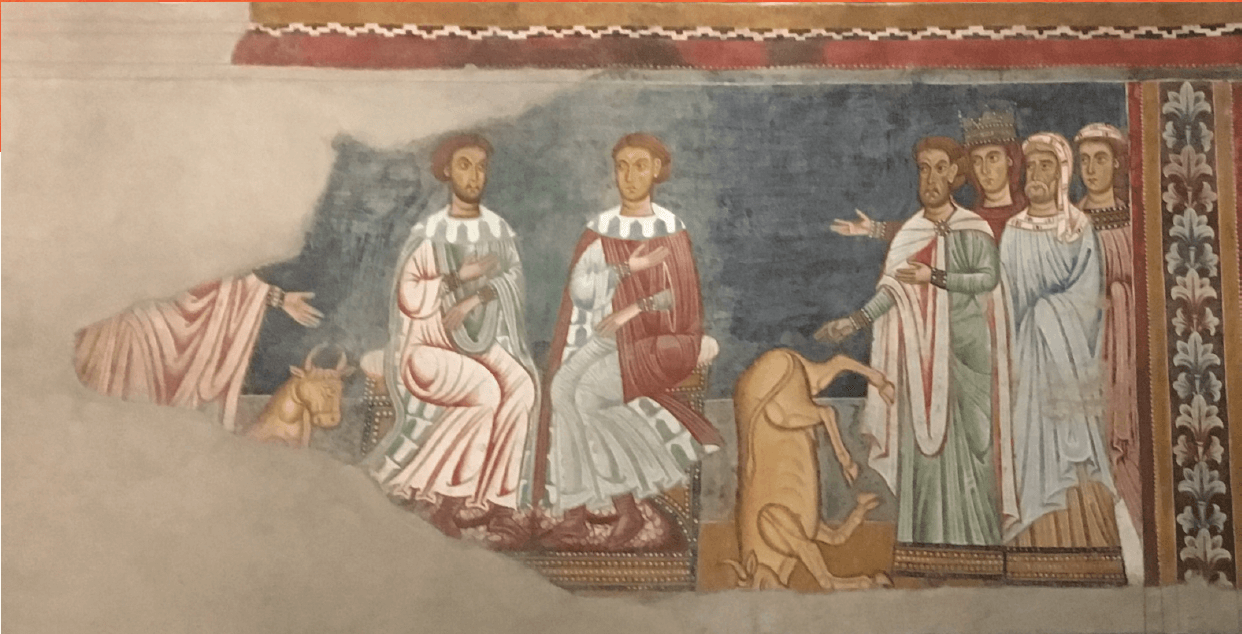Above: Detail from Archie Rand. 326: To Send the Impure from the Temple (Numbers 5:2), 2001-2006. From the series The 613. Acrylic on canvas. 20 x 16 in. Photo by Samantha Baskind
Scholars Insights on Art

Resurrection of the Bull, from The Life and Miracles of St. Sylvester, ca. 1247. Fresco. Oratory of St. Silvester, Basilica of Santi Quattro Coronati, Rome. Photo by author
Rabbi Zambri, in a blue cloak and white-and-gold scarf, stands motionless on the right edge of a fresco painted in the mid-1240s in the Oratory of Saint Sylvester in the Basilica of Santi Quattro Coronati. His wizened mien, his beard, and his garments—particularly his headscarf—betray his identity as a Jew. He stands amid a throng of other Jews gazing sadly toward the center of the fresco, where Emperor Constantine sits enthroned. The fresco depicts the story of Zambri’s powerlessness, his defeat. The first image of a cycle of the life and miracles of the fourth-century Pope Sylvester (d. 335), the scene depicts a debate staged before the Roman imperial court between Zambri and Sylvester, the last of a series of debates staged to convince the Roman Empire to embrace Christianity. According to late fourth- or early fifth-century accounts of Sylvester’s life, Zambri and Sylvester came before the emperor leading a bull. Zambri acts first, killing the bull by whispering the Hebrew name of God into the bull’s ear. Sylvester responds, resurrecting the bull by whispering the name of Christ.i
The church has long been obsessed with keeping Jews visible, and visually distinguishable from Christians.
In the image Zambri stands flanked by male and female attendants, one of whom gestures at a bull that hovers comically: face planted into the dirt with its hind quarters pointed straight into the air. On the left side of the fresco, although badly damaged, the bull is visible again, this time alert, sitting upright and glaring toward Zambri and his attendants. A single hand (a sketch of the frescoes from the seventeenth century reveals the hand is Sylvester’s), points towards the now lively and angry bull. At the center of the scene Emperor Constantine and another man sit enthroned, clearly impressed by what they have witnessed.
In the frescoes of the chapel dedicated to his life, Sylvester’s triumph over Zambri is only the first of his many miracles—the sainted pope slayed a dragon, cured Constantine of leprosy, and even baptized the emperor. Painted nearly a millennium after Sylvester’s death, the chapel was decorated in the 1240s at a moment when the papacy sought to position itself as a power greater even than the emperor. At the time the papacy fought with the Holy Roman Emperor Frederick II, whose troops and supporters repeatedly attacked papal convoys and threatened the Papal States. Popes elected in absentia fled Rome to the relative safety of France, as artists who remained in the city sought to depict the power of the papacy and the deference of Constantine to Sylvester and his successors.
I’ve spent hours in that chapel and hours more poring over images of it—photographs, diagrams, drawings from the seventeenth century—trying to figure out what effect the fresco cycle has on its viewers. In the frescoes I see echoes of the processions of icons of Christ through Rome popular in the Middle Ages, subtle and nuanced use of pictorial space to fix an ideal vantage point for a viewer, complex allegories of eschatology and salvation. But at the root of that visual complexity is Zambri’s silent presence.
In the cycle Zambri functions as a necessary prelude. He and his companions present a metric against which the power of Sylvester’s faith could be easily and demonstrably measured. He personifies the Christian concept of doctrinal supersession: the notion that the Old Testament served as a precursor and prelude to the New Testament. Anything he can do, the fresco shows us, Sylvester can do better. But, by depicting such supersession, the fresco also preserves an image of what has been superseded. The result is the omnipresent Zambri. Even in defeat he remains—a visible Jew at the heart of a profoundly Christian space.
Images of doctrinal supersession abound in Rome, particularly from the Middle Ages. Dozens of churches are decorated with dueling fresco or mosaic cycles: Old Testament on one side, New Testament on the other.ii Medieval rites of church dedication even likened the altar of a Christian church with the stone that Jacob anointed to pray upon after his dream of a ladder to heaven in Genesis. iii Like Zambri, Jews and their stories came to rest permanently in the corners of fresco cycles and in the decorative programs of altarpieces. This desire to depict the superseded not only shaped the art of Rome, it also shaped Rome.
The church has long been obsessed with keeping Jews visible, and visually distinguishable from Christians. Even before Zambri was immortalized in fresco, the Fourth Lateran Council of 1215 decreed “that Jews and Saracens of both sexes in every Christian province and at all times shall be marked off in the eyes of the public from other peoples through the character of their dress.”iv In 1555 Pope Paul IV went so far as to order the construction of a single Jewish quarter in Rome, a ghetto beside the river “to which there is only one entrance and from which there is but one exit.”v There Jews could live in permanent juxtaposition with Christian Rome, permanently visible to the Christians of Rome. Paul’s order might appear to be a strange choice. On the church’s urging kings of Spain, France, England all expelled their Jews in the fifteenth and sixteenth centuries. Meanwhile the Papal States not only didn’t expel their Jews, they refused to let them leave. Instead Paul reconstructed the city into an image just like Zambri’s fresco. Zambri was painted into a corner but left there as a permanent reminder of what had been, what was triumphed over. Paul’s order fixed and framed the entire Jewish community of Rome—making the ghetto a central and visible reminder to Christians of what their faith had superseded.
.
DANNY SMITH is a PhD Candidate in the Department of Art and Art History at Stanford University and the 2020-2021 Marian and Andrew Heiskell/Anthony M. Clark Rome Prize Fellow at the American Academy in Rome.
iAlthough untranslated in full, an edited Latin version of this text, called the Actus Silvestri, is in P. De Leo, Ricerche sui falsi medieovali I: Il Constitutum Constantini; compilazione agiogra-fica del sec. VIII. Note e documenti per una nuova lettura (Reggio Calabria: Editori meridionali riuniti, 1974), 151–221.
iiOn the role of images of the Old Testament in churches see Margaret R. Miles, “Santa Maria Maggiore’s Fifth-Century Mosaics: Triumphal Christianity and the Jews,” The Harvard Theological Review 86, no. 2 (1993): 155–75.
iii Genesis 22:16–22. Lee Bowen describes how the prayer and language of the dedication ceremony reframed Jacob’s stone as a Christian altar. Lee Bowen, “The Tropology of Mediaeval Dedication Rites,” Speculum 16, no. 4 (1941): 469–7.
ivCanon 68 of the Fourth Lateran Council. Translated at: https://sourcebooks.fordham.edu/basis/lateran4.asp.
v Paul IV’s order was in a papal bull entitled Cum nimis absurdum, from 1555. Translated at: https://www.ccjr.us/dialogika-resources/ primary-texts-from-the-history-of-the-relationship/paul-iv.